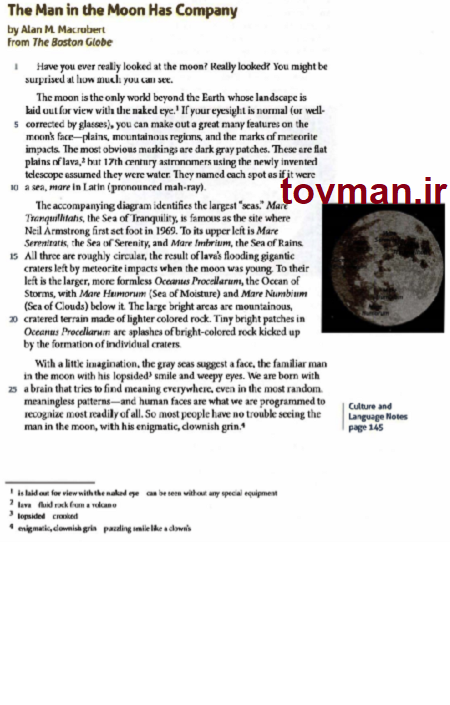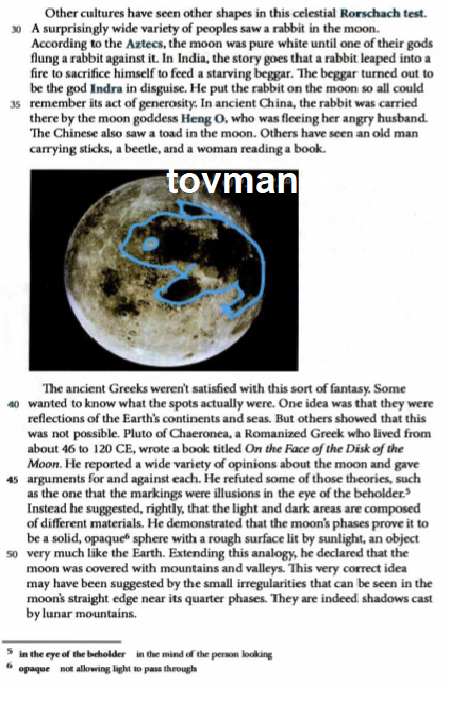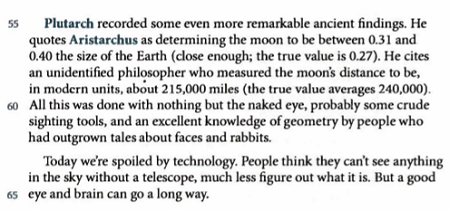
The Man in the Moon Has Company
مرد در ماه همراهی دارد
by Alan M. Macrobert from The Boston Globe نوشتسه شده توسط آلن م. ماکروبرت از بوستون گلوب



Have you ever really looked at the moon? Really looked? You might be surprised at how much you can see
آیا تا به حال واقعاً به ماه نگاه کردی؟ نگاه واقعی؟ ممکن است از اینکه چقدر می توانید ببینید،متعجب شوید؟
The moon is the only world beyond the Earth whose landscape is laid out for view with the naked eye. If your eyesight is normal ( or well-corrected by glasses), you can make out a great many features on the moon's face-plains, mountainous regions, and the marks of meteorite impacts.
ماه تنها دنیای فراسوی زمین است که منظره آن با چشم غیرمسلح قابل دیدن است. اگر بینایی شما طبیعی است (یا با عینک به خوبی اصلاح شده است)، می توانید ویژگی های عالی بر سطح ماه شامل دشت ها، کوه ها ، مناطق و علائمی از اثرات شهاب سنگ ها را ببینید.
The most obvious markings are dark gray patches. These are flat plains of lava, but ۱۷th century astronomers using the newly invented telescope assumed they were water. They named each spot as if it were a sea, mare in Latin (pronounced mah-ray)
واضح ترین نشانه ها، لکه های خاکستری تیره هستند. این ها دشت های مسطح از گدازه های آتشفشانی هستند، اما ستاره شناسان قرن ۱۷ با تلسکوب های تازه اختراع شده تصور می کردند آنها آب هستند. آنها هر نقطه را با این تصور که دریاست mare که در لاتین دریا می شود، نامگذاری کردند(mah-ray تلفظ می شود).
The accompanying diagram identifies the largest "seas:' Mare Tranquillitatis, the Sea of Tranquility, is famous as the site where Neil Armstrong first set foot in ۱۹۶۹. To its upper left is Mare Serenitatis, the Sea of Serenity, and Mare Imbrium, the Sea of Rains All three are roughly circular, the result oflava's flooding gigantic craters left by meteorite impacts when the moon was young.
طرح همراه، بزرگترین دریاها را مشخص می کند. Mare Tranquillitatis دریای Tranquility است. معروف است آن همان جایی است که آرمسترانگ برای اولین بار در ۱۹۶۹ بر روی آن پا گذاشت. در سمت چپ بالای آن، Mare Serenitatis است، دریای Serenity و Mare Imbrium دریای Rains All هر سه تقریباً دایره ای، نتیجه دهانه های آتشفشانی از سیلاب های عظیم گدازه هستند که زمانی که ماه جوان بوده است در اثر شهاب سنگ ها، ایجاد شده اند.
To their left is the larger, more formless Oceanus Procellarum, the Ocean of Storms, with Mare Humorum (Sea of Moisture) and Mare Numbium (Sea of Clouds) below it. The large bright areas are mountainous cratered terrain made of lighter colored rock. Tiny bright patches in Oceanus Procellarum are splashes of bright-colored rock kicked up by the formation of individual craters
سمت چپ آنها Oceanus Procellarum بزرگتر و بی ریخت تر است، اقیانوسی از طوفان ها با Mare Humorum (دریای رطوبت) و Mare Numbium (دریای ابرها) در زیر آن است. مناطق بزرگ و روشن، کوه ها هستند، نواحی که از صخره های رنگی سبک تر ساخته شده اند. با شکل گیری تک تک دهانه های آتشفشانی؛ نقاط روشن کوچکی در Oceanus Procellarum ساخته شده اند، که صخره های رنگی درخشان بی شکل هستند.
With a little imagination, the gray seas suggest a face, the familiar man in the moon with his lopsided smile and weepy eyes. We are born with a brain that tries to find meaning everywhere, even in the most random, meaningless patterns-and human faces are what we are programmed to recognize most readily of all. So most people have no trouble seeing the man in the moon, with his enigmatic, clownish grin
با کمی تخیل، دریاهای خاکستری چهره مردی آشنا با لبخندی کج و چشمهایی گریان را در ماه نشان می دهند. ما با مغزی متولد شده ایم که سعی می کند در همه جا حتی در تصادفی ترین و بی معنی ترین الگوها، معنا پیدا کند و چهره های انسانی همان چیزی است که ما آسان تر از هر چیز دیگر برای تشخیص آنها برنامه ریزی شده ایم. بنابراین بیشتر مردم مشکلی در دیدن مردی با خنده ای مرموز شبیه یک دلقک در ماه ندارند.
Other cultures have seen other shapes in this celestial Rorschach test .A surprisingly wide variety of peoples saw a rabbit in the moon. According to the Aztecs, the moon was pure white until one of their gods flung a rabbit against it. In India, the story goes that a rabbit leaped into a fire to sacrifice himself to feed a starving beggar. The beggar turned out to be the god Indra in disguise.
در فرهنگ های دیگر، اشکال دیگری در آزمون Rorschach فلکی، دیده اند. با کمال تعجب مردم یک خرگوش در ماه دیدند. بنا به گفتهAztecs ماه سفید محض بود تا اینکه یکی از خدایان آنها خرگوش را در آن پرتاب کرد. در هند، داستان این گونه پیش می رود که یک خرگوش به داخل آتش می پرد تا خودش را برای خوراک یک گدای گرسنه قربانی کند. این گدا خدای ایندرا در لباس مبدل بود.
He put the rabbit on the moon so all could remember its act of generosity. In ancient China, the rabbit was carried there by the moon goddess Heng ۰, who was fleeing her angry husband. The Chinese also saw a toad in the moon. Others have seen an old man carrying sticks, a beetle, and a woman reading a book
او خرگوش را روی ماه گذاشت تا همه بتوانند عمل جوانمردانه او را به یاد بیاورند. در چین باستان، خرگوش بوسیله خدای ماه هنگ او که از دست شوهر عصبانی خود در حال فرار بود، به آنجا منتقل شده بود. چینی ها همچنین یک وزغ را در ماه می دیدند. دیگران پیرمردی را دیده اند که چوب ها، سوسک و پیرزنی در حال خواندن کتاب را حمل می کند .
The ancient Greeks weren't satisfied with this sort of fantasy. Some wanted to know what the spots actually were. One idea was that they were reflections of the Earth's continents and seas. But others showed that this was not possible.
یونانیان باستان با این تصاویر تخلیلی راضی نمی شدند. بعضی می خواستند بدانند آن نقاط حقیقتاً چه هستند. یک نظر این بود که آنها بازتاب قاره ها و دریاهای زمین است. اما دیگران نشان دادند که این امکان ندارد.
Pluto of Chaeronea, a Romanized Greek who lived from about ۴۶ to ۱۲۰ CE, wrote a book titled On the Face of the Disk of the Moon. He reported a wide variety of opinions about the moon and gave arguments for and against each. He refuted some of those theories, such as the one that the markings were illusions in the eye of the beholder.
پلوتو یک یونانی رومیایی اهل چارونا که حدود ۴۶ تا ۱۲۰ قبل از میلاد زندگی می کرد کتابی با عنوان روی سطح گرد ماه نوشت. وی نظرات مختلفی در مورد ماه بیان کرد و موافق و مخالف آنها استدلال هایی را ارائه داد. او برخی از آن نظریه ها را همانند آنهائیکه نشانه تخیل در چشم بیننده بود، رد کرد.
Instead he suggested, rightly, that the light and dark areas are composed of different materials. He demonstrated that the moon's phases prove it to be a solid, opaque sphere with a rough surface lit by sunlight, an object very much like the Earth. Extending this analogy, he declared that the moon was covered with mountains and valleys.
در عوض او به درستی پیشنهاد کرد که نواحی تاریک و روشن ترکیبی از مواد مختلف هستند. او نشان داد که مراحل ماه ثابت می کنند که آن یک کره مات و جامد با سطحی سخت است که به وسیله نور خورشید روشن می شود، یک شیء که بسیار شبیه زمین است. با بسط دادن این قیاس او اظهار داشت که ماه با کوهها و دره ها پوشیده شده است.
This very correct idea may have been suggested by the small irregularities that can be seen in the moon's straight edge near its quarter phases. They are indeed shadows cast by lunar mountains
این اندیشه بسیار درست ممکن است به وسیله بی نظمی های کوچکی که می تواند در لبه مستقیم ماه نزدیک مرحله چهارم آن دیده شود، مطرح شود. در حقیقت آنها سایه های هستند که توسط کوه های ماه پخش می شوند.
Plutarch recorded some even more remarkable ancient findings. He quotes Aristarchus as determining the moon to be between ۰.۳۱ and ۰.۴۰ the size of the Earth (dose enough; the true value is ۰.۲۷).
پلوتارچ برخی یافته های باستانی قابل توجه تری را ثبت کرده است. او از آرستارچوس نقل قول می کند که ماه را بین ۳۱. و ۴۰. (به اندازه کافی به مقدار درست که ۲۷. است نزدیک است)اندازه زمین تعیین کرده است.
He cites an unidentified philosopher who measured the moon's distance to be, in modern units, about ۲۱۵,۰۰۰ miles (the true value averages ۲۴۰,۰۰۰) All this was done with nothing but the naked eye, probably some crude sighting tools, and an excellent knowledge of geometry by people who had outgrown tales about faces and rabbits
او به یک فیلسوف ناشناس استناد می کند که فاصله ماه را اندازه گیری کرده است که مطابق واحدها امروزی حدود ۲۱۵۰۰۰ مایل( اندازه واقعی بطور میانگین ۲۴۰۰۰۰) است. همه این ها جز با چشم غیرمسلح انجام نشده است و به وسیله افرادی انجام شده است که احتمالاً برخی ابزارهای بینایی ابتدایی و دانش عالی هندسه داشته اند و از داستان هایی در مورد خرگوش ها و صورت ها؛ پیشی گرفته اند.
Today we're spoiled by technology. People think they can't see anything in the sky without a telescope, much less figure out what it is. But a good eye and brain can go a long way
امروزه ما با فناوری لوس و تباه شده ایم. مردم فکر می کنند که نمی توانند بدون تلسکوپ چیزی در آسمان ببینند و خیلی کم چیزها را می توانند، بفهمند. اما یک چشم و مغز خوب می تواند راه طولانی را طی کند.

